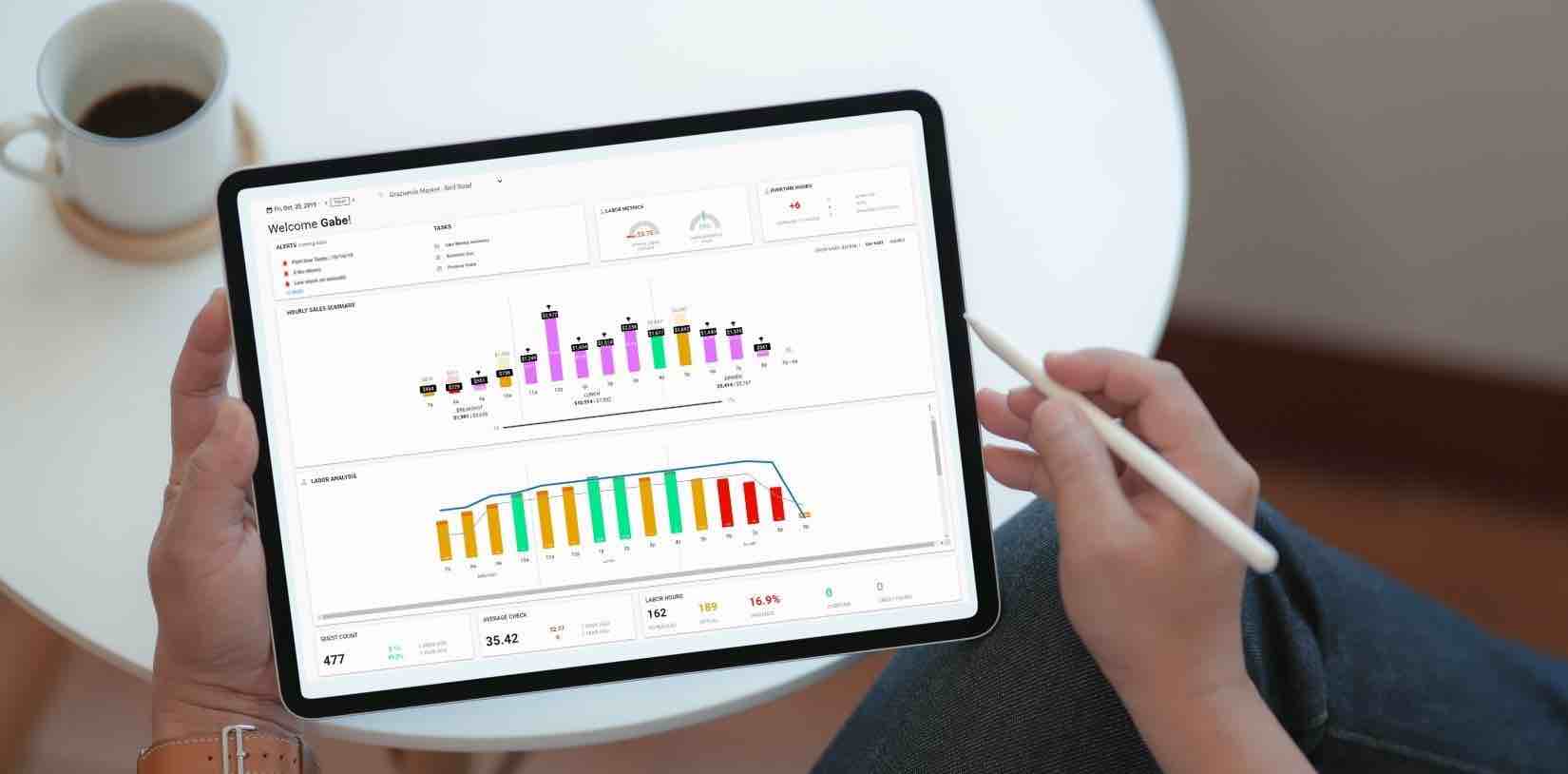Your restaurant operations are constantly generating valuable data. You can leverage this information to improve the way your business operates on a day-to-day basis and over the long-term.
A robust restaurant management solution will offer many kinds of reports about restaurant operations. With restaurant-specific metrics, you can get a detailed look at your profitability, food costs, and labor costs, accessing data that can drive strategic decisions.
There are many different metrics that your restaurant could track and review. Some restaurant operational reporting is standard across the industry, while other granular, niche reports offer value to a certain area of operations. Here are 12 important, but often neglected reports you may want to add to your regular reviews.
Sales reports
Your sales reports are a foundational piece of your operational reporting strategy. The details in your sales reports can help you track performance across multiple store locations, or in one location over time.
Daily Sales Summary
Your daily sales summary (DSS), also known as a flash report, pulls a snapshot of a single day’s sales, labor, and other performance metrics across one location or multiple stores.
Essentially, your DSS is a high-level summary of key metrics that are important to fine-tune every day, like your sales, labor costs, and comps. By keeping an eye on these metrics more frequently, your managers can make real-time adjustments that prevent small operational issues from becoming larger, long-term problems.
Weekly Review by Location
Your weekly sales review report, broken down by location, provides a high-level overview of your revenue. You can break down your weekly sales by day part, service type, guest counts and average check, key controllable expenses, and labor. You can even use it to review historical performance, comparing the week to the previous week or last month, as well as net sales vs. last year’s net sales.
The weekly review can also empower your store-level managers with an immediate feedback loop. As managers review what happened in the past week, and get a snapshot of the current week, they can see the real-time effects of their decisions on labor spend and other store-level expenses.
Food-related operational reports
Food costs, otherwise known as Cost of Goods Sold (CoGS,) are a major expense for your restaurant. Here are a few helpful but occasionally overlooked restaurant operations metrics to review for a more detailed look at CoGS.
Taken together, this food-related operational reporting can have a major impact on your CoGS. As your restaurant consistently cycles through inventory, you are generating a ton of useful data. These restaurant reports listed can turn that data into detailed, actionable insights to help you optimize your food spend.
Received by Purchased Item
Because your vendor pricing has an enormous impact on your overall food cost, consider keeping close tabs on vendor pricing by running receiving reports every two to three days.
First, these operational reports can help you identify pricing errors that lie outside of contracted prices, so you can act quickly to correct contract violations.
You can also view the totals of all items purchased within a date range, as well as the percent of that item in total CoGS, keeping a closer eye on the top-moving items.
Finally, your received by purchased item report allows you to compare the price of items between different store locations or regions to find potential opportunities to revisit prices or renegotiate volume discounts.
Actual vs. Theoretical Analysis
Your actual vs. theoretical (AvT) food cost analysis showcases what you should have theoretically spent on inventory, based on sales, versus what you actually spent, accounting for errors and waste.
AvT analysis after your inventory counts can help you pinpoint where you can add efficiencies and reduce waste within your food cost. First, real-time AvT data can give you an overview of actual usage, theoretical details of menu items sold, expected variance, and waste from your waste tracking system. With this information in hand, you can react in the moment to any immediate necessary changes.
When you’re ready to make larger adjustments to your food cost, your AvT reports can point you in the right direction. You can review AvT variance by category, broken down by count-to-count calculations. In addition, the reports also provide a granular look at the AvT variance by item, allowing you to see total dollar variances by item and decide which items need your attention first.
Your AvT report represents the gap between what was planned, and what was executed. With these variances in your food use identified, you can optimize your food cost and add money back to your bottom line.
Menu Item Analysis
Reviewing your menu items, both for recipes and pricing, shouldn’t be a shot in the dark. Tools like your menu item analysis track the profitability and the popularity of individual menu items by pulling information about price, cost, profit margin, and quantities sold.
By ranking these metrics, you can place items into categories, like “opportunity” (high margin, low popularity”, “star” (high margin, high popularity), “puzzle” (low margin, high popularity) or “dog” (low margin, low popularity).
Each category indicates a different course of action: for instance, you may want to consider promoting “opportunity” menu items or retiring “dog” items from the menu. Overall, you can use these insights to drive your menu engineering decisions and improve profit margins.
Item Pricing Across Location
Item pricing across location allows you to understand the average price paid for an item within a certain period, per store, and then see the same average from all other stores. By sorting these averages by dollar amount, you can view the variance between stores paying the highest and lowest costs on average.
These side-by-side comparisons with category pricing data, or with individual items, can prepare you for new vendor negotiations or purchase agreements.
Labor reports
Many restaurant owners and operators track metrics like total labor cost, as well as labor cost as a percentage of sales (as part of prime cost). However, other labor reports can provide even more helpful detail about your labor spend.
Because your labor cost is a large expense for your restaurant, and it can fluctuate by the day, week, and month, leveraging labor metric reports is key to make the day-to-day adjustments for a streamlined labor budget. When your store-level and scheduling managers have access to this actionable data, they can make informed adjustments while still balancing employee retention concerns and a positive customer experience.
Sales Per Labor Hour and Customers Served Per Labor Hour
Your sales per labor hour (SPLH) plots your labor hours alongside your sales. In addition to SPLH, you can also track customers served per labor hour. This exact metric may shift by day part or day of the week but having a SPLH (or customers served) goal can help you recognize scheduling issues of over and under staffing, maximizing how you are spending your labor hours.
Labor Productivity Analysis by Week
Your labor productivity analysis by week, in essence, is a weekly look at the SPLH and customers served per labor hour metrics above. These simple metrics can be an important marker of labor productivity, allowing you to see what day parts or shifts are the most productive, and which may need to be reviewed. You can also compare productivity across locations to decide which stores may need more attention or training.
Labor Trends
A labor trends graph showcases the current year’s labor dollar spend, percentage, and hours, compared to both scheduled labor and the previous year’s actual labor. You can look at this information by days, weeks, or months, drilling down for specific details. With a visual representation of your labor spend, you can zoom in and out of data points to compare performance and labor efficiency.
Employee vs. Guest Count
Your employee vs. guest count chart displays the number of staff members that are working, compared to the customers served, during a specific period, filtered by location. Combined with your sales forecasting, this report can be essential for your store-level scheduling. By examining the labor peaks of previous weeks, your managers have more information in hand about how many staff members should be scheduled.
Labor Actual vs. Scheduled
Like your AvT food cost report, your labor actual vs. scheduled analysis compares your scheduled labor cost, in theory, versus your actual labor spend, for a specific period. It showcases your labor variance. If you do notice a large variance, and want to examine the source, you can drill down into details attached to the data points, like the job titles, exact date, and employee name.
Overtime Warning
Finally, the overtime warning report helps flag potential overtime, catching any employee that is near overtime, or notifying you about employees that have already hit overtime.
The overtime warning tracks four main data points on a weekly basis: scheduled hours, actual hours, projected hours (calculated by current hours worked + the rest of the scheduled hours), and when the overtime begins.
This report only shows potential overtime, and managers must review and reassess throughout the week to see how numbers fluctuate. However, this information can serve to immediately alert managers with the details they need to make strategic decisions that can control labor costs.
Conclusion
Your restaurant operations reports distill down the large amounts of data into insights that you can use to improve your operations in many different areas. Restaurant-specific reports allow you to dive into the complex details of your revenue, food costs, and labor costs.
If you would like to easily track data and leverage operations reporting to increase efficiency and boost profits, consider a comprehensive, restaurant-specific management solution. Restaurant365 is an all-in-one restaurant management system incorporating financial reporting, operational reporting, restaurant accounting, restaurant operations, inventory management, payroll + HR, and scheduling into a cloud-based platform that’s fully integrated with your POS system, as well as to your food and beverage vendors, and bank.



